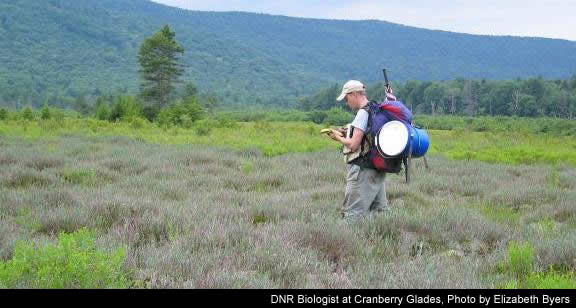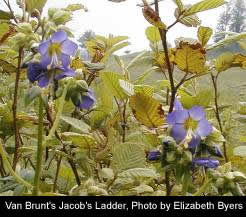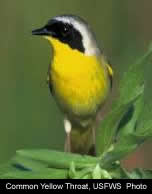

From Cranberry Glades to Cranesville Swamp By Elizabeth Byers A unique part of West Virginia's natural heritage is bursting into life in the Allegheny Mountains . In the rest of the state, spring is well underway, but in the high-elevation wetlands, frost may still cover the ground as the earth wakes. Cold air drainage from the surrounding slopes collects in these high basins, known as “frost pockets.” Many plants and animals that normally occur much farther north live here. Frog choruses are now filling the air in remote high-elevation wetlands. Spring has finally come to the High Alleghenies! Birds find safe, hidden nesting sites in the alder thickets and sedge meadows. A newly hatched damselfly crawls up a long stalk of manna grass to dry its iridescent green wings in the sunlight. Meadow voles and bog lemmings emerge sleepily and hungrily from their burrows in the hummocks of haircap moss. Overhead, a great blue heron wings gracefully in from its roost in the nearby hardwood forest to feed in the wetland. The heron lands in a patch of three-way sedge that lines the edge of a beaver pond, but the beaver family never notices this intrusion. After a bright moonlit night of feeding on tender young alder shoots, the beavers and their kits are dozing through the morning sun in their warm lodge. Together, these plants and animals make up what are known as “ecological communities,” or interacting assemblages of organisms along with their physical environment and the natural processes that affect them. Ecological communities are important to conservation action because they allow us to protect unique groupings of plants and animals along with their food pathways and the natural processes they depend upon for survival. Understanding and classifying ecological communities is made easier by the fact that they tend to repeat across the landscape, wherever similar environmental conditions -- soil, water, climate -- exist. For example, the margins of a newly created beaver pond may support a natural community of rice cutgrass and bur reed – plants that tolerate flooding and can move in quickly to colonize after this natural disturbance occurs. Long after the beavers have come and gone, the wettest parts of the old beaver pond may provide a home for a sphagnum peatland decorated by cranberries and cottongrass. Instead of growing on soil, the sphagnum moss creates its own highly acidic substrate of peat, which restricts the flora to acid-loving plants, including the grass-pink orchid and carnivorous sundew. As time goes on, mossy hummocks begin to form, with sphagnum moss in the hollows and haircap moss on the tops of the hummocks. Meadow voles and ant colonies find a perfectly insulated home inside these hummocks, which can be two feet tall in an undisturbed peatland. Blueberries and chokeberries escape the wettest conditions by seeding on top of the hummocks. Standing in the middle of an orchid-filled cranberry bog, with the scent of spruce in the air, it is easy to imagine that you are in Maine or even Alaska. This is definitely a special ecological community, one of many worth preserving in the Allegheny Mountains of West Virginia. To help land managers make wise conservation choices, DNR Natural Heritage Program ecologists are conducting an ecological assessment of our high-elevation wetland communities. Personnel collect sample plot information across the geographic and environmental range of Allegheny Mountain wetlands. This information, combined with a review of existing scientific data, will lead to a classification of natural wetland types that will directly support conservation action.
An important application of this classification will be to determine which wetland types are the rarest and which are the most common, from both the state and global perspectives. Some of the rarest and most diverse high-elevation wetlands in West Virginia are fed by seepage water from limestone bedrock. Limestone naturally buffers acidity and provides abundant nutrients. These wetlands include rich balsam fir and black ash swamps, which can harbor more than 100 different species of wildflowers, shrubs and herbs beneath their canopy.
DNR ecologists will also compare occurrences of each wetland type to identify which are the best examples based on their size, environmental condition and landscape context. For example, some of the best woodland and forest swamps have been growing undisturbed for many years. Fed by groundwater seepage in floodplains and high basins, they contain the most ancient lineages of northern trees such as balsam fir, black ash and American larch. Clues to the age of these swamps are found in their “impenetrable” nature: it takes decades or even centuries to develop deep organic soils covered by slippery, moss-covered, downed tree trunks, and tall “tip mounds” from the root systems of fallen trees. Shrubs and young trees grow slowly in the dim light under the canopy. Shade-tolerant herbs provide sparse cover on the uneven ground. Different kinds of mosses tuck themselves into niche habitats to take advantage of each variation in light, moisture and nutrients. If you're lucky, you might see a northern waterthrush bob and wag its tail as it searches through the root cavities of a tip mound for the perfect nest site. This article provides a glimpse of just a few of the unique wetland types found within the Allegheny Mountains of West Virginia. During the next two years, DNR ecologists will develop detailed descriptions and conservation priorities for all of the wetland types in this region of the state. The results of this study will become part of West Virginia's Natural Heritage database, which helps landowners and land managers make informed decisions about how to best manage or protect their property. Results will also be shared with the public on the DNR website. We welcome hardy volunteers who would like to backpack in all weather through some of the most beautiful and inaccessible terrain in the state! Volunteers typically help take soil samples, collect insects, measure water chemistry, listen for birds or note plant species. If you are interested in helping, contact Elizabeth Byers at 304-637-0245. Elizabeth Byers is a community ecologist stationed in Elkins. |


